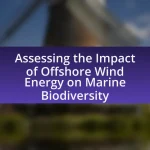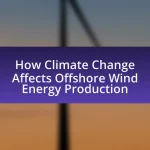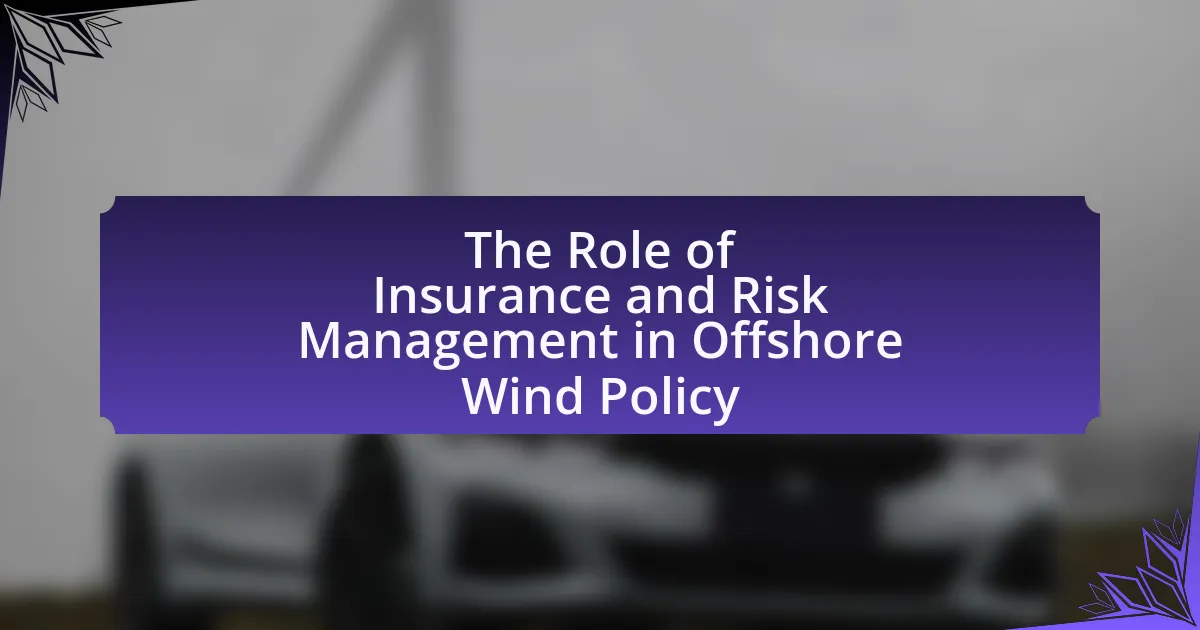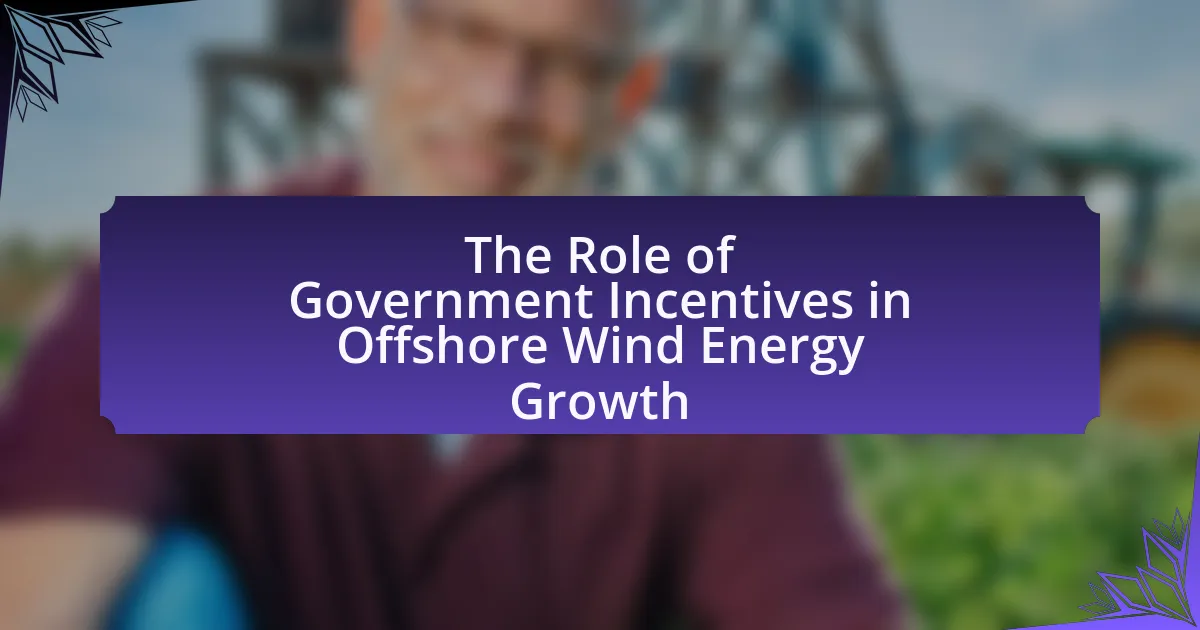Offshore wind policies are regulatory frameworks designed to promote the development of offshore wind energy projects, aiming to enhance renewable energy production, reduce greenhouse gas emissions, and improve energy security. This article examines the environmental impact of these policies, highlighting their role in fostering sustainability while addressing potential ecological risks. Key topics include the assessment methodologies used, the importance of stakeholder engagement, and the balance between environmental benefits and risks associated with offshore wind developments. Additionally, the article discusses best practices for enhancing assessments and the challenges faced in evaluating the impacts of offshore wind initiatives.
What are Offshore Wind Policies and Their Purpose?
Offshore wind policies are regulatory frameworks and guidelines established by governments to promote the development and deployment of offshore wind energy projects. Their primary purpose is to facilitate the transition to renewable energy sources, reduce greenhouse gas emissions, and enhance energy security. For instance, the European Union has set ambitious targets for offshore wind capacity, aiming to generate 300 gigawatts by 2050, which underscores the commitment to sustainable energy solutions. These policies often include incentives, permitting processes, and environmental assessments to ensure that offshore wind projects are developed responsibly and with minimal ecological disruption.
How do Offshore Wind Policies impact environmental sustainability?
Offshore wind policies significantly enhance environmental sustainability by promoting the development of renewable energy sources that reduce greenhouse gas emissions. These policies facilitate the installation of wind farms, which generate electricity without emitting carbon dioxide, thus contributing to climate change mitigation. For instance, a study by the International Renewable Energy Agency (IRENA) indicates that offshore wind energy could reduce global CO2 emissions by up to 4 gigatons annually by 2030. Additionally, these policies often include environmental assessments that help minimize impacts on marine ecosystems, ensuring that wind farm development is conducted responsibly. This dual focus on renewable energy generation and ecological protection underscores the positive relationship between offshore wind policies and environmental sustainability.
What specific environmental factors are considered in these policies?
The specific environmental factors considered in offshore wind policies include marine biodiversity, habitat disruption, water quality, and the impact on local fisheries. Marine biodiversity is assessed to understand how wind farms affect species diversity and populations in the area. Habitat disruption is evaluated to determine how construction and operation may alter the natural environment. Water quality is monitored to ensure that the installation and maintenance of wind turbines do not lead to pollution or degradation of aquatic ecosystems. Additionally, the impact on local fisheries is analyzed to assess how wind farms may affect fish populations and fishing activities, ensuring sustainable practices are maintained.
How do these policies aim to mitigate negative environmental impacts?
These policies aim to mitigate negative environmental impacts by establishing regulations and guidelines that promote sustainable practices in offshore wind energy development. Specifically, they include measures such as environmental impact assessments (EIAs) that evaluate potential ecological effects before project approval, ensuring that biodiversity is protected. Additionally, policies often mandate the use of technology that minimizes noise and habitat disruption during construction and operation phases, which helps to safeguard marine life. For instance, the European Union’s Renewable Energy Directive emphasizes the importance of integrating environmental considerations into energy planning, thereby reinforcing the commitment to reduce adverse effects on ecosystems.
Why is it important to assess the environmental impact of Offshore Wind Policies?
Assessing the environmental impact of Offshore Wind Policies is crucial to ensure sustainable development and minimize ecological harm. This assessment helps identify potential negative effects on marine ecosystems, bird populations, and local communities, allowing for informed decision-making. For instance, studies have shown that offshore wind farms can disrupt migratory patterns of birds and marine life, necessitating careful planning and mitigation strategies to protect biodiversity. By evaluating these impacts, policymakers can enhance the effectiveness of renewable energy initiatives while safeguarding environmental integrity.
What are the potential consequences of not assessing these impacts?
Not assessing the impacts of offshore wind policies can lead to significant environmental degradation and loss of biodiversity. Without proper evaluation, harmful effects on marine ecosystems, such as disruption of habitats and migration patterns, may go unmitigated. For instance, studies have shown that unassessed wind farm installations can result in increased mortality rates for local wildlife, particularly birds and marine mammals, due to collisions and habitat loss. Additionally, failing to assess these impacts can result in public opposition and legal challenges, as communities may resist projects that threaten their local environment. This lack of assessment can also lead to economic repercussions, as unanticipated environmental damage may incur costly remediation efforts and affect local fisheries and tourism industries.
How does public perception influence the assessment process?
Public perception significantly influences the assessment process of offshore wind policies by shaping stakeholder engagement and decision-making outcomes. When the public views offshore wind projects favorably, it can lead to increased support from local communities, facilitating smoother regulatory approvals and funding opportunities. Conversely, negative public perception can result in opposition, delays, and heightened scrutiny during the assessment process. For instance, a study by the National Renewable Energy Laboratory found that community acceptance is a critical factor in the successful deployment of wind energy projects, highlighting that public attitudes directly impact the feasibility and timeline of environmental assessments.
What methodologies are used in assessing the environmental impact of Offshore Wind Policies?
The methodologies used in assessing the environmental impact of Offshore Wind Policies include Environmental Impact Assessments (EIAs), Strategic Environmental Assessments (SEAs), and life cycle assessments (LCAs). EIAs evaluate the potential environmental effects of specific offshore wind projects, considering factors such as biodiversity, water quality, and noise pollution. SEAs, on the other hand, assess the broader environmental implications of policies and plans, ensuring that sustainability is integrated into decision-making processes. LCAs analyze the environmental impacts associated with all stages of a wind farm’s life cycle, from material extraction to decommissioning, providing a comprehensive view of its ecological footprint. These methodologies are essential for ensuring that offshore wind developments are environmentally sustainable and comply with regulatory requirements.
How do quantitative and qualitative assessments differ in this context?
Quantitative assessments in the context of assessing the environmental impact of offshore wind policies focus on measurable data, such as energy output, cost-effectiveness, and carbon emissions reductions, providing numerical evidence to evaluate performance. In contrast, qualitative assessments emphasize subjective evaluations, including stakeholder perceptions, community impacts, and ecological considerations, offering insights into the broader implications of offshore wind policies. For example, quantitative data might reveal a 30% reduction in greenhouse gas emissions, while qualitative feedback could highlight community concerns about visual impacts and noise.
What tools are commonly used for quantitative assessments?
Common tools used for quantitative assessments include statistical software, modeling tools, and data analysis platforms. Statistical software such as R and SPSS allows researchers to perform complex analyses on large datasets, while modeling tools like MATLAB and Simulink enable simulations of environmental impacts. Data analysis platforms, including Excel and Tableau, facilitate the visualization and interpretation of quantitative data. These tools are essential for accurately measuring and evaluating the environmental impacts of offshore wind policies, as they provide the necessary frameworks for data collection, analysis, and reporting.
How are qualitative assessments conducted and what do they reveal?
Qualitative assessments are conducted through methods such as interviews, focus groups, and content analysis, which gather in-depth insights from stakeholders and experts. These assessments reveal nuanced perspectives on the social, economic, and environmental implications of offshore wind policies, highlighting community concerns, stakeholder values, and potential impacts that quantitative data may overlook. For instance, qualitative findings can uncover local attitudes towards wind energy development, informing policymakers about public acceptance and potential barriers to implementation.
What role do stakeholders play in the assessment process?
Stakeholders play a crucial role in the assessment process by providing diverse perspectives, expertise, and local knowledge that inform decision-making. Their involvement ensures that the assessment considers various interests, including environmental, social, and economic factors. For instance, stakeholders such as local communities, environmental organizations, and industry representatives contribute valuable insights that can lead to more comprehensive and balanced assessments. Research indicates that stakeholder engagement enhances the legitimacy and transparency of the assessment process, ultimately leading to better policy outcomes.
Who are the key stakeholders involved in these assessments?
The key stakeholders involved in assessing the environmental impact of offshore wind policies include government agencies, environmental organizations, local communities, and industry representatives. Government agencies are responsible for regulatory oversight and ensuring compliance with environmental standards. Environmental organizations advocate for ecological protection and provide expertise on biodiversity impacts. Local communities are affected by offshore wind projects and their input is crucial for social acceptance. Industry representatives, including developers and energy companies, contribute technical knowledge and economic perspectives essential for project feasibility. These stakeholders collectively influence the assessment process, ensuring a comprehensive evaluation of environmental impacts.
How do stakeholder perspectives shape the assessment outcomes?
Stakeholder perspectives significantly shape assessment outcomes by influencing the criteria and priorities considered during evaluations. Different stakeholders, such as local communities, environmental groups, and industry representatives, bring unique values and concerns that can alter the focus of assessments. For instance, local communities may prioritize social impacts and job creation, while environmental groups might emphasize ecological preservation. Research indicates that stakeholder engagement can lead to more comprehensive assessments, as seen in the study “Stakeholder Engagement in Environmental Assessment: A Review of the Literature” by Vanclay et al., which highlights how diverse viewpoints enhance the robustness of environmental evaluations. This integration of perspectives ensures that assessment outcomes reflect a broader range of interests and can lead to more sustainable decision-making.
What are the key findings from recent assessments of Offshore Wind Policies?
Recent assessments of Offshore Wind Policies indicate that these policies significantly enhance renewable energy production while minimizing environmental impacts. Studies show that well-structured offshore wind policies lead to increased investment in wind energy infrastructure, resulting in a projected global capacity of over 200 GW by 2030. Furthermore, assessments highlight that effective regulatory frameworks can mitigate potential ecological disruptions, such as impacts on marine life and habitats, by incorporating environmental monitoring and adaptive management strategies. These findings underscore the importance of integrating environmental considerations into policy design to balance energy needs with ecological preservation.
What environmental benefits have been identified through these assessments?
The environmental benefits identified through assessments of offshore wind policies include reduced greenhouse gas emissions, improved air quality, and enhanced marine biodiversity. These benefits arise from the transition to renewable energy sources, which significantly lower carbon emissions compared to fossil fuels. For instance, a study by the National Renewable Energy Laboratory found that offshore wind could displace up to 329 million metric tons of carbon dioxide annually by 2050. Additionally, the establishment of wind farms can create artificial reefs, promoting marine life and biodiversity in the surrounding areas.
How do these benefits compare to the potential risks?
The benefits of offshore wind policies, such as reduced greenhouse gas emissions and increased energy security, generally outweigh the potential risks, including impacts on marine ecosystems and visual pollution. Research indicates that offshore wind farms can significantly lower carbon emissions, contributing to climate change mitigation, while studies show that the ecological impacts can be managed through careful site selection and monitoring. For instance, a report by the National Renewable Energy Laboratory highlights that offshore wind can provide up to 20% of U.S. electricity by 2030, significantly reducing reliance on fossil fuels. In contrast, the risks to marine life can be mitigated through established best practices, demonstrating that the overall environmental benefits of offshore wind policies are substantial when managed appropriately.
What long-term environmental impacts have been observed?
Long-term environmental impacts observed from offshore wind policies include alterations in marine ecosystems, changes in fish populations, and effects on bird migration patterns. Research indicates that the construction and operation of offshore wind farms can lead to habitat modification, which affects local biodiversity. For instance, studies have shown that the presence of wind turbines can create artificial reefs, attracting certain fish species while potentially displacing others. Additionally, the noise generated during construction has been linked to changes in behavior among marine mammals. Furthermore, the placement of turbines can interfere with migratory routes of birds, leading to increased mortality rates. These findings underscore the need for careful planning and monitoring to mitigate adverse effects on marine life and avian populations.
What challenges are faced in assessing the environmental impact of Offshore Wind Policies?
Assessing the environmental impact of Offshore Wind Policies faces several challenges, including data availability, ecological variability, and stakeholder engagement. Data availability is often limited due to the complexity of marine environments, making it difficult to gather comprehensive baseline information. Ecological variability complicates assessments, as different marine species and habitats respond uniquely to wind farm installations, leading to uncertainties in predicting impacts. Additionally, stakeholder engagement poses a challenge, as conflicting interests among local communities, environmental groups, and industry stakeholders can hinder consensus on environmental assessments and policy implementation. These challenges highlight the need for robust methodologies and collaborative approaches to effectively evaluate the environmental impacts of offshore wind initiatives.
How do regulatory frameworks affect the assessment process?
Regulatory frameworks significantly influence the assessment process by establishing the guidelines and standards that must be followed during evaluations. These frameworks dictate the methodologies, data requirements, and stakeholder engagement necessary for conducting assessments, ensuring that they align with legal and environmental standards. For instance, the National Environmental Policy Act (NEPA) in the United States mandates comprehensive environmental reviews for federal projects, which directly shapes how assessments are conducted for offshore wind policies. This legal requirement ensures that potential environmental impacts are thoroughly evaluated, promoting transparency and accountability in decision-making.
What are the limitations of current assessment methodologies?
Current assessment methodologies for evaluating the environmental impact of offshore wind policies are limited by their reliance on outdated data, lack of comprehensive metrics, and insufficient stakeholder engagement. These methodologies often utilize historical data that may not accurately reflect current environmental conditions or technological advancements, leading to potentially misleading conclusions. Additionally, many assessment frameworks fail to incorporate a holistic set of ecological and socio-economic indicators, which can result in an incomplete understanding of the impacts. Furthermore, the engagement of local communities and stakeholders in the assessment process is frequently inadequate, limiting the effectiveness and acceptance of the findings.
What best practices can enhance the assessment of Offshore Wind Policies?
Best practices that can enhance the assessment of Offshore Wind Policies include the integration of comprehensive stakeholder engagement, the use of robust data collection methods, and the implementation of adaptive management frameworks. Comprehensive stakeholder engagement ensures that the perspectives of local communities, environmental groups, and industry experts are considered, which can lead to more informed decision-making. Robust data collection methods, such as environmental monitoring and impact assessments, provide empirical evidence that supports policy evaluations. Adaptive management frameworks allow for ongoing assessment and modification of policies based on new data and changing environmental conditions, ensuring that the policies remain effective and relevant over time. These practices collectively contribute to a more thorough and effective assessment of Offshore Wind Policies, ultimately leading to better environmental outcomes.
How can stakeholder engagement be improved during assessments?
Stakeholder engagement can be improved during assessments by implementing structured communication strategies that facilitate active participation. Engaging stakeholders early in the assessment process allows for their input to shape the evaluation criteria and objectives, ensuring that diverse perspectives are considered. Research indicates that utilizing tools such as surveys, workshops, and public forums can enhance stakeholder involvement, leading to more comprehensive assessments. For instance, a study by the National Renewable Energy Laboratory found that inclusive stakeholder engagement practices significantly increased the quality and acceptance of environmental assessments in renewable energy projects.
What innovative approaches can be adopted for more effective assessments?
Innovative approaches for more effective assessments of offshore wind policies include the use of advanced data analytics and modeling techniques. These methods enable the integration of large datasets, such as environmental impact data, wind patterns, and marine biodiversity, to create comprehensive assessments. For instance, machine learning algorithms can analyze historical data to predict potential environmental impacts more accurately, allowing for proactive measures to mitigate risks. Additionally, participatory assessment frameworks that involve stakeholders, including local communities and environmental experts, can enhance the relevance and acceptance of the assessments. Research has shown that stakeholder engagement leads to more informed decision-making and better policy outcomes, as evidenced by studies conducted by the International Renewable Energy Agency, which highlight the importance of inclusive approaches in environmental assessments.




